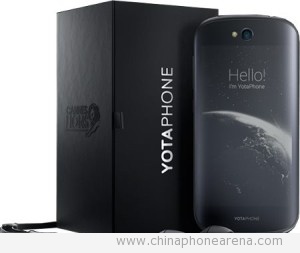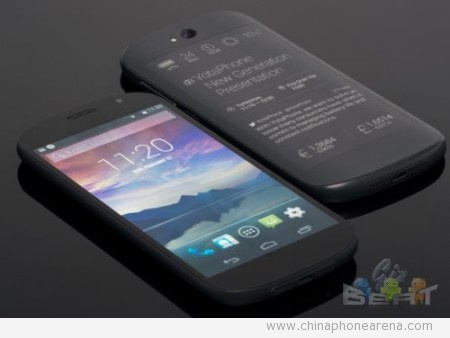YotaPhone 2 World’s First Dual Screen Smartphone
It is hard to argue with the saying that two heads are better than one. Smartphone manufacturers know this: We see all these phones with dual cameras, dual flashes, and more recently, two glass layers encasing the devices. But what about two screens?
Russian company, YotaPhone, has released the world’s first dual screen phone, the YotaPhone 2. The main display is a 5.0 inch 1080p resolution AMOLED display. The secondary screen is found on the rear panel of the phone and is sized at 4.7 inches, with a 960 x 540p resolution e-ink display. The rear panel is black matte which allows for easy viewing of the black and white display. Both screens are layered with Corning Gorilla Glass 3.
The secondary display is fully touch-sensitive and can be personalized easily: it can be rigged to display notifications and information of the user’s choosing. This setup will allow for significant power saving, as checking notifications won’t require as much power as waking up the power hungry full-color display.
Under the hood is a Qualcomm Snapdragon 800 SoC with a quad core Krait 400 CPU clocked at 2.3GHz. RAM storage is healthy at 2GB while phone memory is specced at 32GB.
The rear camera is equipped with an 8MP sensor, while the front-facing camera has a maximum resolution of 2MP. The phone will be running Android 4.4 out of the box, with YotaPhone’s firmware tweaks in place, to accommodate the secondary screen functions.
The device will be powered by a non-removable 2500mAH battery and is capable of wireless charging. The battery need not be very large because the phone was designed under the premise that the secondary screen would have power saving benefits.
 Additionally, since the phone is equipped with two screens, the thickness and weight of the phone is significantly increased. Therefore, if the battery was made even larger, it could make the phone an inconvenience to carry around.
Additionally, since the phone is equipped with two screens, the thickness and weight of the phone is significantly increased. Therefore, if the battery was made even larger, it could make the phone an inconvenience to carry around.
YotaPhone has now put a potential standard which other manufacturers may try to live up to. It is interesting to see if dual screen models will start cropping up later on in the year.
At present, the YotaPhone 2 is available to Asian and European markets at around the $850 range. The company aims to further expand into the US and Canadian markets, but there is still no certainty on this specific phone’s availability in the said regions.
Full Specifications of the phone are seen below.
| SoC | OS | Android OS, v4.4.3 (KitKat) |
| Chipset | Qualcomm MSM8974 Snapdragon 800 | |
| CPU | Quad-core 2.3 GHz Krait 400 | |
| GPU | Adreno 330 | |
| Network | Technology | GSM / HSPA / LTE |
| 2G bands | GSM 850 / 900 / 1800 / 1900 | |
| 3G bands | HSDPA 850 / 900 / 1900 / 2100 | |
| 4G bands | LTE 800 / 1800 / 2600 (Bands 3, 7, 20) | |
| Speed | HSPA, LTE Cat4 150/50 Mbps | |
| GPRS | Yes | |
| EDGE | Yes | |
| SIM Support | Single SIM | Nano-SIM |
| Memory | RAM | 2GB |
| ROM | 32 GB, no microSD | |
| Primary Display | Type | AMOLED capacitive touchscreen, 16M colors |
| Size | 5.0 inches | |
| Resolution | 1920 x 1080p | |
| Protection | Corning Gorilla Glass 3 | |
| Secondary Display | Type | e-ink |
| Size | 4.7 inches | |
| Resolution | 960 x 540p | |
| Protection | Corning Gorilla Glass 3 | |
| Camera | Primary | 8 MP, 3264 x 2448 pixels, autofocus, LED flash |
| Secondary | 2.1 MP | |
| Comms | WLAN | Wi-Fi 802.11 a/b/g/n/ac, dual-band, hotspot |
| Bluetooth | v4.0, A2DP | |
| GPS | Yes, with A-GPS, GLONASS | |
| NFC | Yes | |
| Radio | FM radio | |
| USB | microUSB v2.0 | |
| Features | Sensors | Accelerometer, gyro, proximity, compass |
| Messaging | SMS(threaded view), MMS, Email, Push Mail, IM | |
| Browser | HTML5 | |
| Java | Yes, via Java MIDP emulator | |
| – Active noise cancellation with dedicated mic | ||
| – Wireless charging | ||
| – MP4/H.264 player | ||
| – MP3/WAV/eAAC+/Flac player | ||
| – Photo/video editor | ||
| – Document viewer | ||
| Battery | Non-removable Li-Ion 2500 mAh battery | |
| Body | Dimensions | 144.9 x 69.4 x 9 mm (5.70 x 2.73 x 0.35 in) |
| Weight | 145 g (5.11 oz) |







Leave a Reply